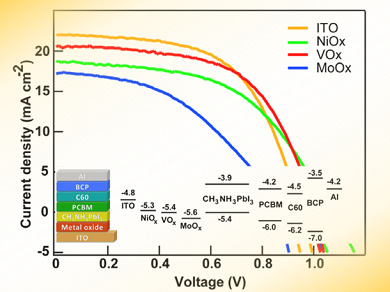Organic-inorganic hybrid perovskite solar cells are attracting intense attention owing to their low cost and achievement of efficiencies (≈ 21 %) comparable to those of other solar cells, such as copper indium gallium selenide (CIGS) and polysilicon solar cells. In order to achieve such efficiencies, the interfacial layers between the perovskite film and the contacts are extremely important. Normally, in planar perovskite solar cells two such layers are used to efficiently extract the electrons and holes which then migrate to the two separate contacts.
Leone Spiccia and colleagues, Monash University, Australia, have concluded that the underlayer could be eliminated in inverted structure devices (ITO/metal oxide/CH3NH3PbI3/PCBM/C60/BCP/Al). A comparison of devices made with different metal oxide underlayers such as, for example, NiOx, a commonly used material in the inverted perovskite solar cells, with devices lacking such an underlayer revealed very similar device performances.
Such a finding opens the way to the design of perovskite solar cells with a single interfacial layer and much simpler device structures. This would contribute to further reductions in manufacturing costs, making these devices more competitive in the PV market.
- Efficient Perovskite Solar Cells Employing Inorganic Interlayers,
Manda Xiao, Mei Gao, Fuzhi Huang, Alexander R. Pascoe, Tianshi Qin, Yi-Bing Cheng, Udo Bach, Leone Spiccia,
ChemNanoMat 2016.
DOI: 10.1002/cnma.201500223




